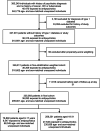Excess cardiometabolic risk in children and adolescents initiating antipsychotic treatment compared to young adults: results from a nationwide cohort study
- PMID: 39810688
- PMCID: PMC11733449
- DOI: 10.1002/wps.21279
Excess cardiometabolic risk in children and adolescents initiating antipsychotic treatment compared to young adults: results from a nationwide cohort study
Abstract
Antipsychotic treatment is associated with cardiometabolic risks that may be especially detrimental to children and adolescents. In this Danish population-based cohort study, we included individuals with psychiatric diagnoses who initiated antipsychotics in 2000-2021 at age 6-31 years. We assessed the risk of cardiometabolic adverse events up to 10 years following incident exposure to antipsychotics, compared to age- and sex-matched unexposed individuals with psychiatric diagnoses. Cox regression models were used to calculate hazard ratios (HRs) after adjustment using high-dimensional propensity scores, including age, sex, calendar time, hospital diagnoses, and prescription drug use. HRs were compared between incident exposure in youths (6-17 years) and young adults (18-31 years), and between incident exposure in children (6-11 years) and adolescents (12-17 years). The total cohort consisted of 335,093 individuals, including 36,092 subjects exposed to antipsychotics (children and adolescents: 8,547, mean follow-up: 6.8±3.2 years; young adults: 27,545, mean follow-up: 6.5±3.4 years) and 299,001 age-, sex- and calendar-matched unexposed subjects. The incidence rate of cardiometabolic events was higher for young adults initiating antipsychotics than for children and adolescents (23.2 vs. 14.1 events/1,000 person-years). However, the adjusted excess risk of cardiometabolic events was significantly higher in exposed compared to unexposed children and adolescents (HR=1.87, 95% CI: 1.71-2.05) than in exposed compared to unexposed young adults (HR=1.46, 95% CI: 1.40-1.51) (p<0.001). The excess risk of cardiometabolic events was even higher when antipsychotic treatment was initiated before age 12 years (HR=2.44; 95% CI: 1.99-2.98) than at age 12-17 years (HR=1.69, 95% CI: 1.52-1.87) (p=0.012). Concerning specific cardiometabolic outcomes, there was an effect of age at antipsychotic initiation on the risks of metabolic syndrome (p=0.011) and obesity (p<0.001), that were higher among children and adolescents than young adults. Thus, initiation of antipsychotic treatment before age 18 years is associated with an excess risk of cardiometabolic events compared to age- and sex-matched youths with psychiatric disorders but unexposed to antipsychotics. The excess cardiometabolic risk is significantly higher than that of individuals who start antipsychotic treatment in early adulthood, and significantly higher for treatment onset in childhood compared to adolescence. On the basis of these findings, recommendations are provided about the use of antipsychotics in children and adolescents.
Keywords: Cardiometabolic adverse events; adolescents; antipsychotics; children; excess risk; metabolic syndrome; obesity.
© 2025 World Psychiatric Association.
Similar articles
-
Comparative cardiometabolic risk of antipsychotics in children, adolescents and young adults.Eur Child Adolesc Psychiatry. 2021 May;30(5):769-783. doi: 10.1007/s00787-020-01560-1. Epub 2020 May 29. Eur Child Adolesc Psychiatry. 2021. PMID: 32472205
-
[Metabolic side effects of risperidone in early onset schizophrenia].Encephale. 2010 Jun;36(3):242-52. doi: 10.1016/j.encep.2009.10.008. Epub 2009 Dec 1. Encephale. 2010. PMID: 20620267 French.
-
Risk of diabetes in children and adolescents exposed to antipsychotics: a nationwide 12-year case-control study.J Am Acad Child Adolesc Psychiatry. 2014 Sep;53(9):971-979.e6. doi: 10.1016/j.jaac.2014.04.023. Epub 2014 Jun 23. J Am Acad Child Adolesc Psychiatry. 2014. PMID: 25151420
-
Cardiometabolic adverse effects of long-term antipsychotic treatment in children and adolescents with non-psychotic disorders: a systematic review of available evidence.Eur Child Adolesc Psychiatry. 2025 Jun 5. doi: 10.1007/s00787-025-02771-0. Online ahead of print. Eur Child Adolesc Psychiatry. 2025. PMID: 40471419 Review.
-
Umbrella Review: Association Between Antipsychotic Drugs and Metabolic Syndrome Hallmarks in Children and Adolescents.J Am Acad Child Adolesc Psychiatry. 2024 Mar;63(3):313-335. doi: 10.1016/j.jaac.2023.04.018. Epub 2023 Jun 23. J Am Acad Child Adolesc Psychiatry. 2024. PMID: 37391174
References
-
- Piao J, Huang Y, Han C et al. Alarming changes in the global burden of mental disorders in children and adolescents from 1990 to 2019: a systematic analysis for the Global Burden of Disease study. Eur Child Adolesc Psychiatry 2022;31:1827‐45. - PubMed
-
- ten Have M, Tuithof M, van Dorsselaer S et al. Prevalence and trends of common mental disorders from 2007‐2009 to 2019‐2022: results from the Netherlands Mental Health Survey and Incidence Studies (NEMESIS), including comparison of prevalence rates before vs. during the COVID‐19 pandemic. World Psychiatry; 2023;22:275‐85. - PMC - PubMed
-
- Cervesi C, Park SY, Galling B et al. Extent, time course, and moderators of antipsychotic treatment in youth with mood disorders: results of a meta‐analysis and meta‐regression analyses. J Clin Psychiatry 2017;78:347‐57. - PubMed
-
- Park SY, Cervesi C, Galling B et al. Antipsychotic use trends in youth with autism spectrum disorder and/or intellectual disability: a meta‐analysis. J Am Acad Child Adolesc Psychiatry 2016;55:456‐68.e4. - PubMed
-
- Nakane S, Tanaka‐Mizuno S, Nishiyama C et al. Trends in prescribing antipsychotics for children and adolescents in Japan: a descriptive epidemiological study using a large‐scale pharmacy dataset. Child Psychiatry Hum Dev 2023;54:1250‐7. - PubMed
LinkOut - more resources
Full Text Sources


